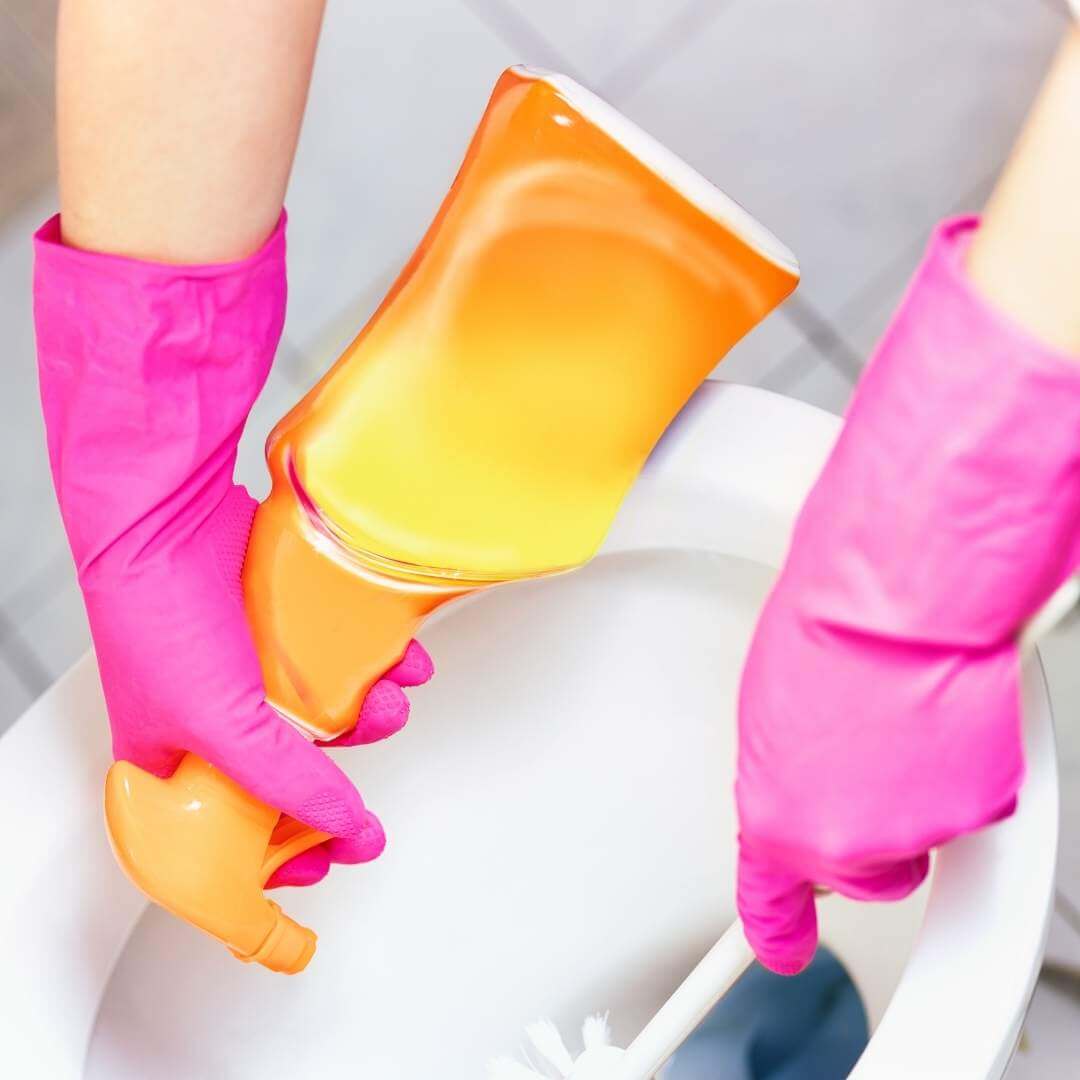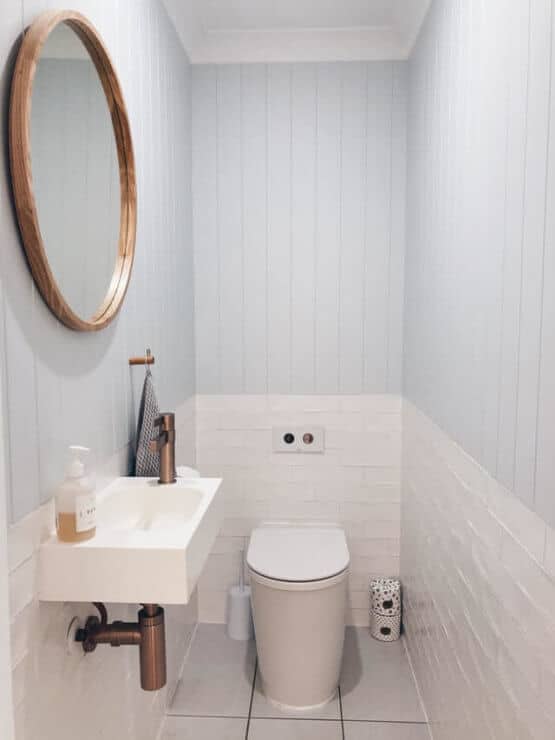Does CLR remove brown toilet stains, you may ask? The answer is yes, but we are going to explore it deeper.
It is certain that every household, at least once, had a problem with toilet stains, which can be very difficult to clean. What cleaning agent to use and how to use it, we are going to find out in a bit.
Does CLR Remove Brown Toilet Stains

First, if you wonder why brown stains appear in the toilet in the first place, you should know that it depends on water hardness. Water is hard when it contains minerals such as magnesium, calcium, and iron.
When this kind of water dries, it leaves those mineral deposits which cause hard stains in your toilet. You should definitely know the difference between stain from daily use, which you can remove just by using the brush, and hard stains that are more vivid in color.
The color of the stain depends on which minerals are in the water. It can go from deep red, orange, and rusty brown to brownish-black.
This type of stain is more difficult to remove, requiring a stronger cleaning agent, for example, CLR.
Too much manganese as well as build up limescale can cause brown toilet stains, because dirt and bacteria develop layers over time.
Additionally, the type of piping in your home affects the formation of brown toilet stains. If you have metal pipes, the water passing through it can pic up metal elements from piping coating and cause those brown stains.
What is CLR
- Industrial Strength: CLR PRO Calcium, Lime...
- Fast Acting: Quickly removes calcium, lime...
- Multi-Purpose: Versatile cleaner for home or...
CLR (Calcium, Lime, Rust) is a non-toxic, acid-based product. It quickly dissolves hardened rust and calcium buildup. There are several different acids in the formula, such as:
- Gluconic acid
- Citric acid
- Lactic acid
- Glycolic acid
- Sulfamic acid
Also, CLR has some other ingredients, such as water and surfactants, that make the product effective and safe for usage.
So, does CLR remove brown toilet stains, and how the process looks depends on where those stains are in the toilet and if you are using CLR correctly.
If stains are above water in your toilet bowl, you can easily apply CLR to it and scrub it with a toilet brush. Let it sit for 2 minutes, and then flush the toilet couple of times to properly rinse away the product.
On the other hand, if the stains are below the water line, you have to empty the toilet water first. The first step is to turn off the water source for the toilet and then plunge the toilet to force the water to go through the pipe.
Now, you can apply CLR to the stains, scrub them and leave it for 2 minutes. Finally, you can turn the water source back on and flush the toilet to rinse it all. You can also repeat the process for even better results.
How Long Can I Leave CLR In My Toilet
You should not leave CLR in your toilet for more than about 2 minutes since it can cause damage to the ceramic or porcelain finish of the toilet bowl.
How To Use CLR In Toilet Tank
Keeping your toilet tank in good condition will prolong the life of your toilet. So, you can use CLR for the toilet tank too.
Over time, the tank develops pasty substance, which is most likely calcium and lime buildup, because the tank interacts with water more than the toilet bowl itself. Every time you flash the water, it goes through the jets around the rim, and then the tank fills up again with it.
Here are 5 steps on how to use CLR in a toilet tank:
- Step 1: Turn Off Water Supply
- Step 2: Remove Surface Dirt
- Step 3: Apply CLR
- Step 4: Scrub The Tank
- Step 5: Turn Water Supply On and Rinse
So, if you want to apply CLR in your toilet tank, first you need to empty the tank in order to take full advantage of the CLR agent.
Then remove all surface dirt that s accumulated from the bottom and sides of the tank. For this process, you can use a scrubbing brush or a sponge.
Now, you can apply CLR on the bottom and sides of the tank. Wait for about 2 minutes to get results. Also, you should use some protective gear, such as gloves, a mask, or eye protection, to stay as safe as possible.
After 2 minutes, you can scrub the tank if needed, depending on how bad the stains are. In the end, turn back on the water supply, let it fill, flush the toilet, and you are all done.
What Should You Not Use CLR On?
You should NOT use CLR on:
- Wood
- Clothing
- Wallpaper
- Carpeting
- Natural stones
- Brass
- Copper
- Aluminum
- Galvanized metals
- Any painted, coated, or sealed surfaces
Because CLR is a highly concentrated chemical, which means that cleaning these items can ruin their appearance and function.
Furthermore, it is good to know that CLR should not be used in an unventilated space.
Also, it is not recommended to mix CLR with other household cleaners or bleach since mixing acids with bleach creates toxic chlorine gas, and mixing with other household chemicals can result in toxic fumes too.
Is Vinegar Better Than CLR
Vinegar is an acidic ingredient in nature and works to dissolve hard mineral deposits and remove rust stains.
It softens the stains enough for you to remove them by scrubbing, or it can lift the build-up from the base of your toilet bowl. Most bottles of white vinegar contain around 5 percent acetic acid.
Vinegar is safer to use, it can not cause damage to the toilet, and you can mix it with other ingredients, such as baking soda, to get better results.
But vinegar is less effective since CLR is a chemical cleaner with 15 times more concentration and enhanced qualities to beat tougher stains; in other words, 1 cup of pure CLR is as effective as a whole gallon of vinegar.
How Do You Clean A Heavily Stained Toilets
It is important to clean your toilet often, in order to avoid hard stains as well as stop the spread of germs. Besides CLR, which we discussed earlier in the text, and many others chemical agents on the market, here are some other ingredients that you can use to clean a heavily stained toilets.
Baking soda
Baking soda is an excellent ally for cleaning the toilet bowl. It’s a natural deodorizer that helps a lot in sanitizing surfaces and removing tough stains. Also, it’s completely safe to use and can be paired with other natural ingredients, such as vinegar and fresh lemon, which is high in citric acid.
You can simply sprinkle the toilet with a cup of baking soda, leave it for 30 minutes, then spray or squirt with vinegar to moisten, scrub with a bowl brush, flush away, and you are all done.
Coca-Cola
The acid in the soda help remove the stains, but it should sit overnight. Before applying the soda, you should empty the toilet bowl. The next day just flush the toilet and scrub with toilet brush if needed.
Borax
Borax is a strong cleaning product every household has, and you can use it to clean hard water stains in the toilet. First, apply 1/4 cup of borax in your toilet bowl and scrub with a toilet brush. Then, add 1 cup of vinegar or lime, and swish around again. In the end, flush the water.
Bottom Line
In a nutshell, hard water cause toilet stains, which can be different colors, according to the minerals in the water, such as magnesium, calcium, and iron. As a result, stains can go from deep red to brownish-black.
CLR agent can remove those hard stains from your toilet since it is a chemical cleaner with 15 times more concentration and enhanced qualities to beat tougher stains than natural ingredients.
You should leave it for 2 minutes, not more, to avoid any damage to your toilet. This agent should not be used on wood, clothing, wallpaper, etc., since it can ruin their function. Using it in your toilet tank is safe, but you need to follow the five steps given.
When it comes to vinegar, it is safer but less effective, even though you can mix it with other ingredients such as baking soda, lime, or borax.

Michael Davis is a heating & plumbing expert who currently works as independent contractor in SC. He also writes for Plumbertip.
For almost 10 years he worked on various plumbing tasks across South Carolina.



